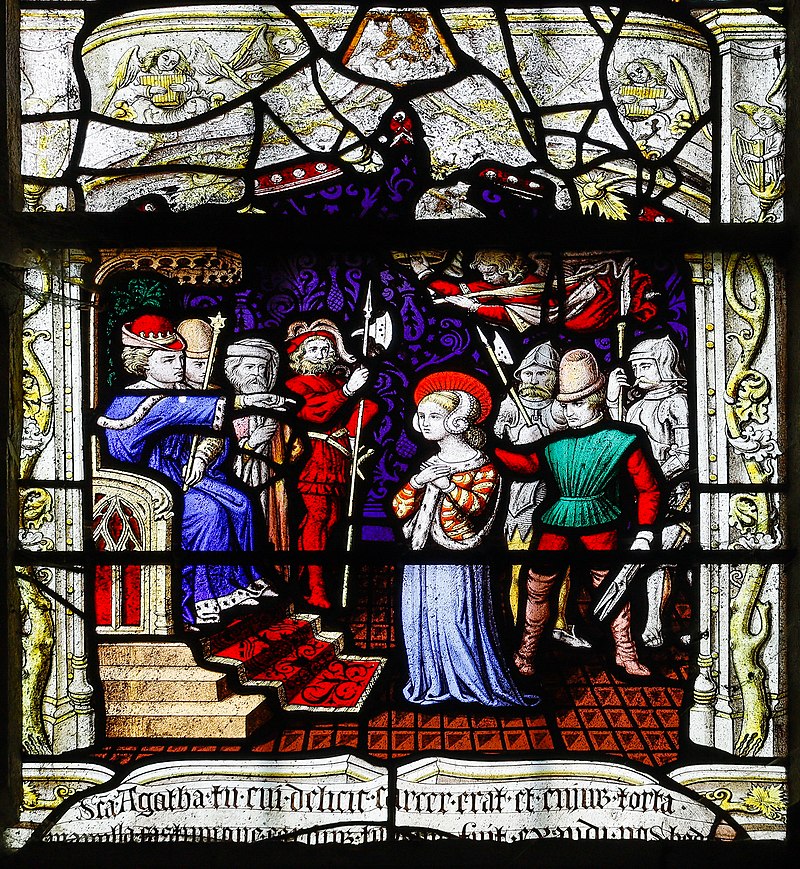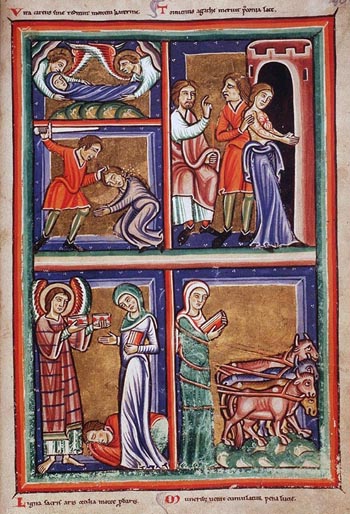The Saint of the Day
 |
 |
 |
 |
 |
 |
 |
St. Agatha - February 5
Comments of Prof. Plinio:
St. Agatha (c. 231 - c. 251) was a great heroine of the early Church. Her name is included in the list of great Saints who are invoked every day in the Canon of the Holy Mass. She belonged to one of the noblest families of Sicily and was the most endowed heiress of the area. Quintianus, the provost of Sicily, turned his attention to her because of her great beauty and riches. Suspecting she was Catholic he demanded she make sacrifice to the idols. When she refused, he sent her to prison.
 Agatha, realizing that God was asking her to prepare herself to martyrdom, said this prayer: “Jesus Christ, Lord of every created thing, Thou dost see my heart and know my desires. Take possession of me and everything that belongs to me. Thou art my Shepherd, my God, I am Thy sheep. Made me worthy to be victorious against the Devil.”
Agatha, realizing that God was asking her to prepare herself to martyrdom, said this prayer: “Jesus Christ, Lord of every created thing, Thou dost see my heart and know my desires. Take possession of me and everything that belongs to me. Thou art my Shepherd, my God, I am Thy sheep. Made me worthy to be victorious against the Devil.”
The governor, who knew her only by name, was impressed by her beauty and was surprised that a person so extraordinarily gifted could be so far removed from any worldly concerns.
Miscalculating the purity of that young lady and overtaken by a violent passion, Quintianus made indecorous proposals to her. Agatha rejected them violently by declaring that under no circumstances would she allow him to approach her.
The governor did know the resistance of those who frequent the Sacraments. He pretend to desist his plans, but put her in the keeping of Aphrodisia, a woman of very bad fame, so that she could be corrupted. However, Aphrodisia was unable to make any progress and, after a month of useless attempts, she asked Quintianus to take Agatha away from her place, telling him: “Sooner should the stones wax soft, and iron turn to soft lead, than turn the courage of this maid or to take from her the Christian Faith.”
The martyrdom of the noble Sicilian then started. The governor summoned her before his tribunal and asked her: “Are you not ashamed to lower yourself to the condition of slave of this Christian Religion since you are from a noble family?”
 Agatha replied to that man who was a slave of vices: “The servitude of Christ is liberty and is above all the riches of kings.”
Agatha replied to that man who was a slave of vices: “The servitude of Christ is liberty and is above all the riches of kings.”
To these words the governor answered with a harsh slap to the face of the young noblewoman. He threatened her with the worst tortures and threw her in a dungeon.
The next day the tyrant again ordered that the maid be brought before him and again ordered her to adore the gods to escape the torments. She replied: “Nay, but let thou renounce thine idols which be of stones and of wood, and adore thy Maker who made heaven and earth, and if thou dost not do so, thou shalt be tormented in the perpetual fire in hell.”
He order that she be stretched on a wheel and tormented her members, and burned her body with red-hot copper plates. When she still refused to renounce her Religion, he ordered that her breasts should be drawn and cut off with iron pincers.
Since she did not die despite all these mutilations, she was again thrown in prison and the guard received express orders to prevent her from receiving any relief from her pains. During the night the Apostle St. Peter appeared to her in a dream, praised her for her courageous conduct and cured her with diverse ointments in the name of Our Lord Jesus Christ.
When Agatha awoke and saw herself completely cured, having her breast restored to her, she sang a canticle of thanksgiving to God. Hearing the canticle, the curious guards approached. Seeing that her body was no longer ignominiously mutilated, they fled, filled with fear.
 Agatha’s companions in prison advised her to flee. She, however, did not want to abandon the palm of martyrdom and said: “That shall never happen. The keepers of the prison shall not suffer any harm for my sake, nor shall I lose my crown. I shall abide in the Faith of Jesus Christ my Lord, who hath comforted and healed me.”
Agatha’s companions in prison advised her to flee. She, however, did not want to abandon the palm of martyrdom and said: “That shall never happen. The keepers of the prison shall not suffer any harm for my sake, nor shall I lose my crown. I shall abide in the Faith of Jesus Christ my Lord, who hath comforted and healed me.”
Four days later she was led again before her iniquitous judge, who could not hide his astonishment at what he saw. But, instead of being conquered by the evidence, he became irate and, foaming with hatred, ordered that she be immediately undressed and rolled over broken glasses and then thrown over burning embers.
While the young woman was subjected to this humiliating and painful trial, the ground where the holy virgin was rolled on began to shake like an earthquake, and a part of an enormous wall fell down upon Silvain, counselor of Quintianus, and upon Fastion his friend, by whose counsel she had been so tormented. Seeing so many miracles the people of Catania were abashed and revolted against the brutality of the judge.
Once again she was thrown in prison. Agatha then asked God to bring her to His glory, saying: “I pray Thee that Thou take my spirit, for it is time that Thou make me to depart from this world and to come to Thy mercy.”
God heard the virgin Agatha and what the iron and the embers were unable to achieve was accomplished by the prayer of that maiden, who passed through two martyrdoms without dying.
Article from O Legionário, February 4, 1940
St. Agatha (c. 231 - c. 251) was a great heroine of the early Church. Her name is included in the list of great Saints who are invoked every day in the Canon of the Holy Mass. She belonged to one of the noblest families of Sicily and was the most endowed heiress of the area. Quintianus, the provost of Sicily, turned his attention to her because of her great beauty and riches. Suspecting she was Catholic he demanded she make sacrifice to the idols. When she refused, he sent her to prison.

A medieval depiction of the tortures of St. Agatha
The governor, who knew her only by name, was impressed by her beauty and was surprised that a person so extraordinarily gifted could be so far removed from any worldly concerns.
Miscalculating the purity of that young lady and overtaken by a violent passion, Quintianus made indecorous proposals to her. Agatha rejected them violently by declaring that under no circumstances would she allow him to approach her.
The governor did know the resistance of those who frequent the Sacraments. He pretend to desist his plans, but put her in the keeping of Aphrodisia, a woman of very bad fame, so that she could be corrupted. However, Aphrodisia was unable to make any progress and, after a month of useless attempts, she asked Quintianus to take Agatha away from her place, telling him: “Sooner should the stones wax soft, and iron turn to soft lead, than turn the courage of this maid or to take from her the Christian Faith.”
The martyrdom of the noble Sicilian then started. The governor summoned her before his tribunal and asked her: “Are you not ashamed to lower yourself to the condition of slave of this Christian Religion since you are from a noble family?”

A medieval depiction of the tortures of St. Agatha
To these words the governor answered with a harsh slap to the face of the young noblewoman. He threatened her with the worst tortures and threw her in a dungeon.
The next day the tyrant again ordered that the maid be brought before him and again ordered her to adore the gods to escape the torments. She replied: “Nay, but let thou renounce thine idols which be of stones and of wood, and adore thy Maker who made heaven and earth, and if thou dost not do so, thou shalt be tormented in the perpetual fire in hell.”
He order that she be stretched on a wheel and tormented her members, and burned her body with red-hot copper plates. When she still refused to renounce her Religion, he ordered that her breasts should be drawn and cut off with iron pincers.
Since she did not die despite all these mutilations, she was again thrown in prison and the guard received express orders to prevent her from receiving any relief from her pains. During the night the Apostle St. Peter appeared to her in a dream, praised her for her courageous conduct and cured her with diverse ointments in the name of Our Lord Jesus Christ.
When Agatha awoke and saw herself completely cured, having her breast restored to her, she sang a canticle of thanksgiving to God. Hearing the canticle, the curious guards approached. Seeing that her body was no longer ignominiously mutilated, they fled, filled with fear.

St Agatha presented with pincers, her most famous instrument of torture
Four days later she was led again before her iniquitous judge, who could not hide his astonishment at what he saw. But, instead of being conquered by the evidence, he became irate and, foaming with hatred, ordered that she be immediately undressed and rolled over broken glasses and then thrown over burning embers.
While the young woman was subjected to this humiliating and painful trial, the ground where the holy virgin was rolled on began to shake like an earthquake, and a part of an enormous wall fell down upon Silvain, counselor of Quintianus, and upon Fastion his friend, by whose counsel she had been so tormented. Seeing so many miracles the people of Catania were abashed and revolted against the brutality of the judge.
Once again she was thrown in prison. Agatha then asked God to bring her to His glory, saying: “I pray Thee that Thou take my spirit, for it is time that Thou make me to depart from this world and to come to Thy mercy.”
God heard the virgin Agatha and what the iron and the embers were unable to achieve was accomplished by the prayer of that maiden, who passed through two martyrdoms without dying.
Article from O Legionário, February 4, 1940
 | |
|
|
The texts of both the biographical data and the comments come from personal notes taken by Atila S. Guimarães from 1964 to 1995. Given the fact that the source is a personal notebook, it is possible that at times the biographic notes transcribed here will not rigorously follow the original text read by Prof. Plinio. The commentaries have also been adapted and translated for TIA’s site.